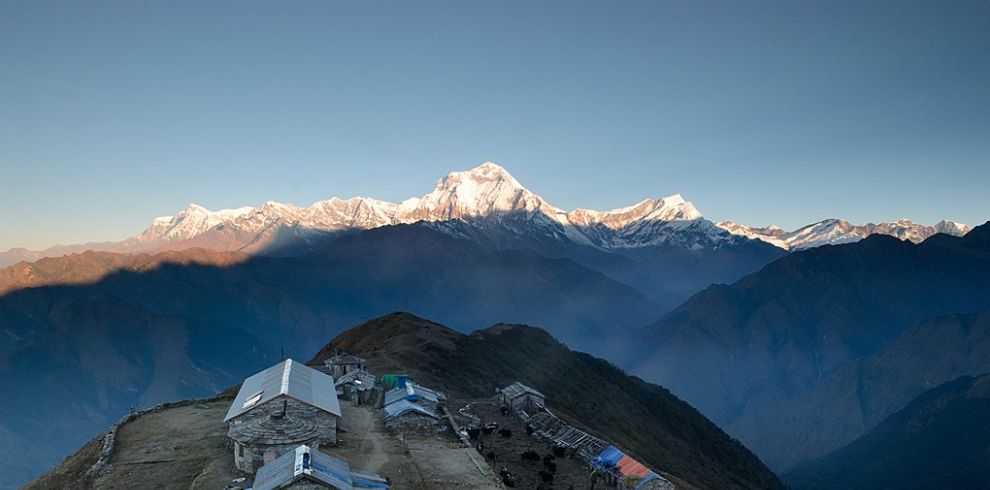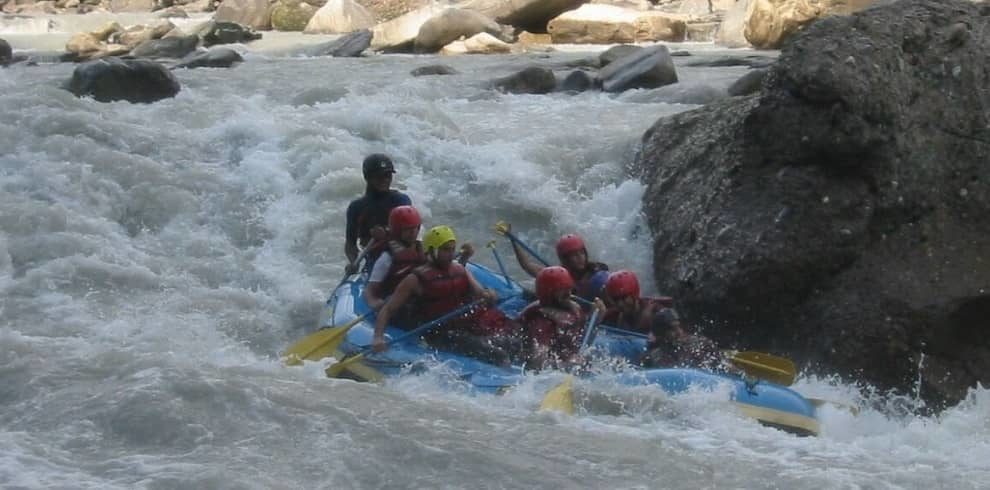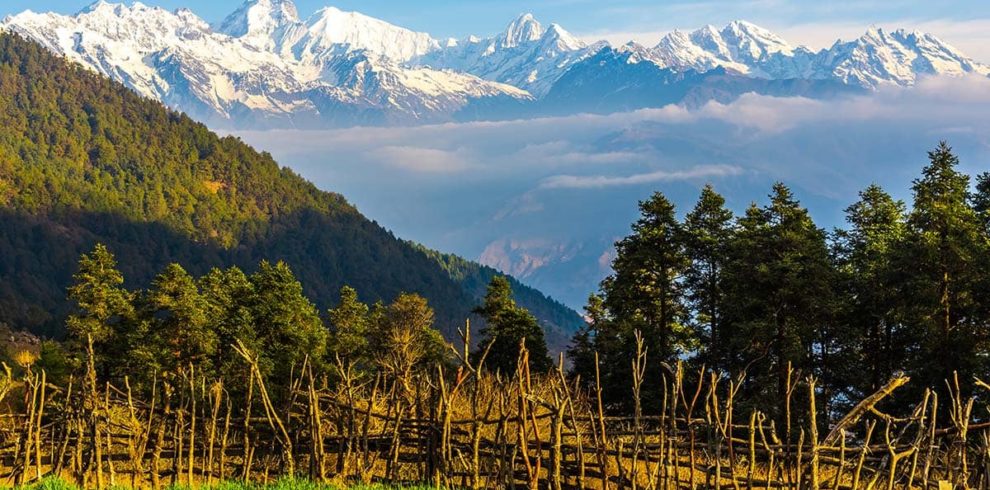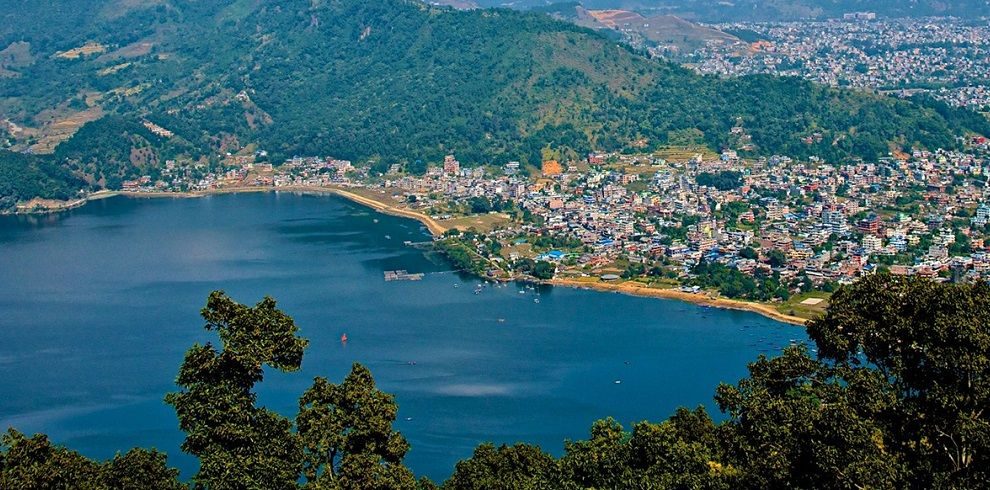Introduction To Khopra Danda Trek In Nepal
The Khopra Danda Trek in the Annapurna region is a newly opened route.
The Khopra Danda Trek takes you to off-the-beaten-path destinations such as Mt. Dhaulagiri, Annapurna (I, II, III, and south), Hiunchuli, Machhapuchhre, Lamjung Himal, and Nilgiri, where you will see terraced farms, traditional communities, fast-flowing rivers, lush forests, and awe-inspiring mountain views.
You will walk through rhododendron forests with Himalayan fauna such as pheasants and yaks along the trek. You can also go to the holy Khayar Lake if you like.
This journey also includes a visit to Poon Hill (3,210m / 10,531ft), from which you can see the Annapurna range, Dhaulagiri, Nilgiri, Hiunchuli, and Machhapuchhre.
Our vacation starts with a lovely ride from Kathmandu to Kimche, passing through Pokhara, Nayapul, and Syauli Bazaar. Our journey will begin in Kimche and end at Ghandruk, a Gurung village.
After spending the night in Ghandruk, we travel to Bayli Kharka the next morning, passing through Tadapani on the route.
The trail we’ll be traveling is a little-used off-the-beaten-path. There are a few lodges in Bayli Kharka that add a homey atmosphere to your walk.
From Bayli Kharka, you will reach Khopra Danda on the third day of the walk. Our route will take us via Chistibang meadows and wooded areas. Dhaulagiri, Dhamphus Peak, Tukuche Peak, Nilgiri, Annapurna I, and Annapurna South can all be seen from the trails.
You have the option of seeing Khayar Lake after waking up at the Khopra Danda. The terrain is fairly steep, and we’ll be trekking for almost five hours before arriving at Khopra Danda.
We travel from Khopra Danda to Swanta village, which is famous for its community-run cheese production.
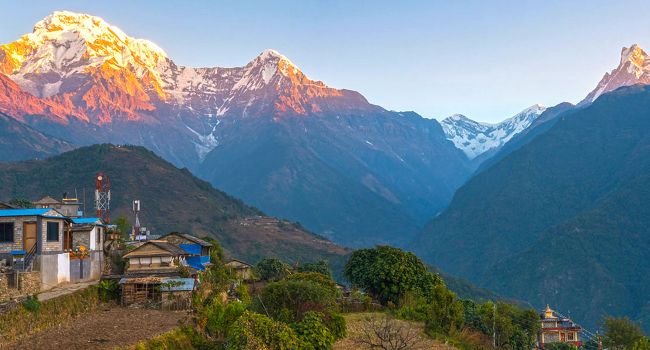
The following day, we trek from Swanta to Ghorepani. However, before arriving in Ghorepani, we’ll stop in Chittre village to join the classic Annapurna Circuit Trek trails.
The final day of this walk will begin early in the morning at Ghorepani with an ascent to Poon Hill, a world-famous viewpoint.
Early in the morning, the morning sun rays paint the surrounding mountains golden from Poon Hill. Poon Hill is one of the most popular photography locations, and we’ll shoot as many photos as we like.
We return to Ghorepani and climb to Birethanti after taking in the wonderful views from the Poon Hill viewpoint. We’ll take a bus from Birethanti to Pokhara via Nayapul. Pokhara is where your trek comes to a finish.
Our vacation begins with a 6-7 hour bus ride (about 200 kilometers) from Kathmandu to Pokhara, which is included in the package. However, we can arrange a local flight from Kathmandu to Pokhara (20 minutes) and/or from Pokhara to Kathmandu for an extra fee. For tour briefing, we propose that our valued clients arrive in Kathmandu by 3 p.m., one day before the trip departure date. We’ll double-check your luggage to make sure you have all of the necessary gear and equipment, as well as set your expectations, during the briefing.
Highlights Of Khopra Danda Trek In Nepal
- 2 nights in Pokhara, a lovely lake city.
- Off-the-beaten-path adventures
- Awe-inspiring vistas of Dhaulagiri, Annapurna South, and Nilgiri from a local cheese factory in Paudwar
- Optional trek to Kaire Lake, a spiritual site.
- Poon Hill Ghandrung hamlet Khopra Danda crest offers spectacular sunrise views.
Benefits Of Khopra Danda Trek In Nepal
- Transfer to and from the hotel from the airport is included in a private vehicle.
- During the trek, you can store your excess luggage for free.
- Pulse oximeter for detecting early indicators of altitude sickness or other health difficulties at high altitudes by monitoring blood oxygen saturation levels.
- Medical supplies
- If you don’t have your own, sleeping bags and down jackets can be rented.
Equipment list for Trek
You’ll need to change your gear and equipment depending on the trekking season. This, on the other hand, is a list of requirements that we have developed.
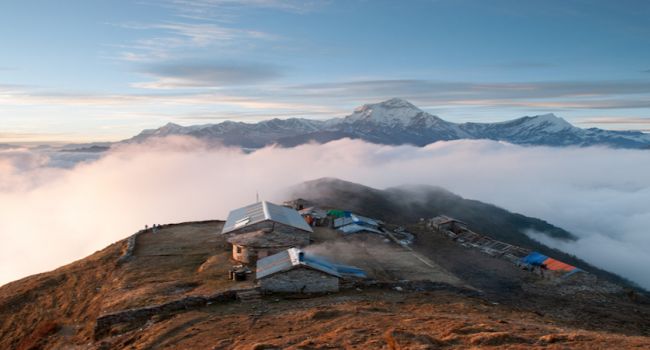
Head
- Scarf or hat for the sun
- Winter hat, insulating hat, or a hat with a wide brim
- Extra batteries for the headlight
Face
- Sunscreen
- Sunglasses that block UV rays
- Wipes for the face and body
Hands
-
Lightweight gloves
-
Heavyweight winter gloves
Body
- Shirts for hiking
- Shirt with a long sleeve made of synthetic fiber.
- Rain jacket with hood
- Jacket made of fleece
- Cotton pants that are light and airy.
- T-shirt (bring lightweight wool)
- Underwear made of polypropylene
- Jacket with down feathers (available for rent in Kathmandu)
- Sweater
- Jacket and pants that are waterproof
Footwear
- Boots for Hiking
- Socks made of thick wool (Take an extra pair of thick light socks)
Essential gear
- A daypack or a backpack (Size depends on whether you take a porter or not)
- Bottle with a heating element
- Purification of water
- Pole for hiking
- Bag for sleeping (-15 degree bag is best for high altitude trekking)
Toiletries
- a drying towel of medium size
- Toothbrush
- Toothpaste
- Deodorant/floss/toilet paper
- Biodegradable soap in a bar
- a pair of nail clippers
- Mirror, little
Personal accessories
-
Money
-
Watch
-
Cell phone
-
Camera
Extra items
- Kit for first aid
- Extra passport pictures and passport photocopies
- Pencil and notebook
- Binoculars
Khopra Ridge Trek Trip Information
Trek Start
You will arrive at Kathmandu’s Tribhuvan International Airport. One day prior to the trek’s departure date, you must attend a trip briefing. We’ll take a tourist bus to Pokhara on your departure date. Every day at 7 a.m., the tourist bus leaves Kathmandu. Pokhara serves as the starting point for the Khopra trek.
The cost of a tourist bus ticket from Kathmandu to Pokhara and back is included in this package. For an extra fee, you can fly from Kathmandu to Pokhara or Pokhara to Kathmandu. The flight is around 20 minutes long.
Airport pick up and drop
On your arrival, we will pick you up from the airport and drop you off at your hotel in a private vehicle, and vice versa on your departure. Our agent will be holding a booklet with your name on it at the Tribhuvan International Airport. As a welcoming gesture, they will either give you a Khada or Marigold garland and then drive you to your accommodation. To take use of this free service, please provide your flight information.
Trek Accommodation
The Khopra Danda trip includes a five-night stay in a trekking region and two nights in a Pokhara hotel. You’ll be staying in the best lodges available.
At Ghandruk and Ghorepani, we provide two nights of bed and board with an attached bathroom. Stay at Bayeli Kharka, Khopra Danda, and Swanta for three nights in a basic room. (Rooms are usually shared by two people.)
In the available lodges, solo hikers can stay in a single private room with an attached bathroom, as well as single private lodging in other locations.
Two nights at a hotel in Kathmandu are required before and after the hike, however, they are not included in the package. There are hotels in Kathmandu to suit all budgets and preferences.
At an additional cost, trekking sections will have hot showers and Wi-Fi.
Meals During Khopra Trek
Because the Khopra walk takes place at such a high altitude, you’ll need to eat well. The food in trekking areas will be nutritious and wholesome. You will, however, have fewer options.
During the walk, there will be six breakfasts, six lunches, and five evenings.
The following are some of the most popular menu items:
Oatmeal, Corn Flakes, French toast with jam, butter, and cheese, Honey Tibetan bread or Chapati, and local Tsampa porridge are among the six breakfast options. Fruits, Vegetables, Eggs, Pancakes, Muesli Breads Drinks that are heated (varieties of teas and coffees, hot chocolates, etc.)
Dhal, Bhat, Tarkari, Tibetan Bread, Soups, Momo (dumplings), Macaroni meals, Tenduk Spaghetti Noodles, Thukpa, Pasta, Vegetable curry, Potatoes, Vegetables, Salad Pizza (Tomato, Mushroom, Mixed), Snacks (Papad, Prawn), Desserts (Rice Pudding, Apple Pie), etc.
Five dinners – Dhal, Bhat, Tarkari, Tibetan Bread, Soups, Sherpa Stew, Steaks, Sandwiches, Momo (dumplings), Macaroni, Tenduk Spaghetti, Noodles Thukpa, Pasta, Vegetable curry, Potato items, Vegetable and salad Pizza (Tomato, Mushroom, Mixed), Snacks (Papad, Prawn), Korean Raman, Desserts (Rice
The menu blends local, Asian, and western cuisine, however, the menu gets shorter as we climb the stairs. At high elevations, we strongly advise you to consume fresh vegetables and liquids (green tea, garlic soup (must), lemon tea, hot lemon, ginger tea, etc.).
Though there will be lots of non-vegetarian options, we advise against eating meat because the meat in hiking regions may not be sanitary. We also recommend avoiding dairy, cheese, alcohol, caffeinated beverages, and hot chocolate.
Note that the package does not include lunch or dinner in Pokhara.
All personal bills (alcoholic drinks, hot (tea/coffee), and cold drinks) in tea houses, lodges, or cafés are excluded from the package, save for regular meals (Breakfast, Lunch, and Dinner with seasonal fruits).
Best Time To Trek Khopra Danda
For the Khopra Trek, the weather is the most important consideration. Trekking to Khopra can be done at any time of year, but it is simpler in the autumn and spring when the weather is clear and there is no rain.
Trekking in the winter is difficult due to the cold and snow, while hiking in the summer coincides with the rain, making the trail wet and slick. Adventurers, on the other hand, find these challenges fascinating.
Throughout the year, we organize treks to Khopra Danda.
In summary, below is detailed weather information for the Khopra Danda Trek locations at high altitudes.
March-May (Spring)
The Khopra walk is easier in the spring (March-May), and the views are spectacular. The weather is pleasant, the rainfall is light, and the trekking conditions are ideal during this season. The average daily temperature at high altitudes ranges from 5 to 15 degrees Celsius. Because the lower sections are warmer, the walk is enjoyable for all nature enthusiasts. In the spring, the trekking season begins after March.
By April, you’ll be able to see red, pink, and white rhododendron flowers along the walk routes. From mid-March until mid-May, the temperature begins to rise. Mountains, valleys, villages, and farmland are all visible thanks to the low temperatures and beautiful skies.
June – August (Summer)
Summer in Nepal lasts from June to August, thus temperatures in the trekking areas are rather high. However, Nepal’s summer coincides with the rainy season, making trek trails wet and slick. Monsoon season usually starts at the end of June and lasts until the second week of August.
At high heights, summer day temperatures range from 15°C to 25°C. Temperatures at night range from 5°C to 15°C. Mornings in the summer are normally clear, with clouds forming in the afternoon and dissipating at night.
Though the rain may make the walkways slick, the plants receive much-needed rain and bloom during this season, providing much-needed green cover to the mountain vegetation.
September – November (Autumn)
The Khopra Danda trek is best done in the autumn (September, October, November), as it is in the spring. Autumn brings temperate temperatures, light winds, clear skies, and little rain, ideal circumstances for a good hike. At night, clear heavens provide for spectacular stargazing.
By early September, the monsoons will have passed, and fall days in the trekking regions will be mild to warm. In high heights, daytime temperatures can reach 20°C, while nighttime temperatures are around 5°C. The monsoon greens fade to a golden/amber color, creating a stunning contrast against the pristine blue skies.
The air is clear, the grains in the fields are maturing, and the lowlands are lush. Dashain and Tihar, two of Nepal’s most important festivals, fall at this time, adding to the festive atmosphere of your walk.
December – February (Winter)
Winter is here (December – February) Treks in the Khopra Danda are less popular than treks in the spring or fall. During the winter, the trekking regions can be freezing, but this inspires brave hikers. The temperature in the trekking areas can drop below -5 degrees Celsius.
From December through early February, it is the coldest. Temperatures begin to rise after late February.
Winter skies are normally exceptionally clear, and mountain views are at their best – with snow crowns – despite the cold. The trails have the least amount of traffic. Winter hikes may not be suitable for inexperienced hikers, but experienced hikers can finish this walk without difficulty in the winter.
The weather in the Himalayas is changeable and unpredictable.
Physical Condition & Experience Requirements
The Annapurna Khopra Trip is a moderately difficult trek in the Annapurna region. The hike takes about 4 to 5 hours per day, with frequent stops to take in the breathtaking mountain vistas. The trek paths to Khopra Danda are not particularly steep, although they do climb and dip quite steadily.
This trek can be completed by hikers who can hike for 4 to 5 hours per day at a reasonable pace while carrying a light day pack. Physical exertion is required when trekking at higher altitudes.
To accomplish the 7-day Khopra Danda trip, you must be in good physical condition and have strong determination. Participants with pre-existing medical concerns including heart, lung, or blood disorders should let us know before signing up for the walk.
Trekking group/single
We organize both group and private treks. Group discounts are available dependent on the size of your group. The larger your group, the greater the savings. Please see our price list for further information. Simply click the – we offer group discounts – link on the right.
Having said that, we can accommodate groups of any size and even add an assistant guide for groups of 12 or more.
A typical day on the Trek
Every day will be different, with activities such as enjoying the journey and scenery, shooting photos, and touring the surrounding villages. As you trek, qualified expert Sherpas will provide you with information and historical details about the locations.
The majority of your luggage will be carried by our porters, but you may need to bring a small normal bag for your valuables.
After breakfast, we head off on the day’s walk between 7 and 8 a.m., depending on the length and character of the hike. After three to four hours of hiking, we’ll stop for lunch and an hour of recuperation before continuing our journey.
The afternoon stroll is usually shorter, lasting between two and three hours. You can enjoy the refreshments after you get to your overnight lodge/tea house/tent, and then you are free to explore the area.
Dinner is served between 6 and 7 p.m. After supper, you have some free time to engage in casual chat. The excursion leader/guide will give you an overview of the next day’s activities. After the briefing, you can play monopoly, play cards, or watch mountaineering films on board. Before going to bed, the majority of our guests study the Nepali language or read novels.
How to Communicate During the Trek?
For a nominal fee, you can use the internet at the lodges, but after you reach high elevations, you’ll have to communicate via phone.
Our office will connect with all of our valued clients by Signal, WhatsApp, phone, Messenger, and other means at least once a day to ensure that they are fine, safe, and comfortable.
You might get some signals along the route, depending on the network you’re using, but they’re not particularly strong at high altitudes. In Kathmandu, though, you may easily obtain a local sim card.
In most cases, you will be able to connect to the internet at all of the lodges/hotels where you will be staying.
Wi-Fi is usually available during the walk-in lodges/lodges for an additional fee.
Extra personal expenses on trekking
In Kathmandu, the clients are responsible for their own meals and lodging. You may book them conveniently online, or we can do it for you if you want.
Similarly, you must pay for visa processing, travel insurance, beverages, trip snacks, hot and cold drinks, souvenirs, and tips to trekking crew members, among other things. Bringing cash (Dollars) and changing it to Rupees is recommended. In the Nepali market, only Rupees are accepted.
Electricity, battery recharge, water on trekking
In all lodges, electricity for camera and phone recharge is available at an additional expense. During the trip, you can either buy pre-packaged mineral water or bring boiled water with you. You will also receive a water-purifying pill.
We advise against drinking water from rivers or taps because the water may be contaminated.
Trek travel insurance
This Trek requires travel insurance. Before beginning the hike, all trekkers must produce a copy of their comprehensive travel insurance policy certificate to us. Medical and emergency repatriation must be covered, as well as helicopter rescue and evacuation costs at high altitudes (up to 6000m).
Based on the experiences of our former clients, we may recommend insurance firms to you. We do not, however, sell insurance coverage. Within a week of booking the trek, we ask that all trek participants provide us with their comprehensive insurance information. In an emergency, we’ll prepare a speedy, successful rescue using your insurance policy and other documentation you supplied us.
Before you acquire travel insurance, call your provider and double-check that it covers helicopter rescue and evacuation up to 6000 meters. Do not rely solely on the material of the insurance company’s website.
How to get a visa for Nepal?
Except for Indian nationals, all foreigners must have a valid visa to enter Nepal. At Tribhuvan International Airport and Nepal’s borders with India and Tibet, you can obtain an on-arrival visa. Visit www.immigration.gov.np. for additional details.
You’ll need a passport that’s valid for at least six months, a passport-size photo, and visa fees to apply for a visa. A 30-day visa costs $50 at the moment (to be paid in cash).
A free visa will be given to children under the age of ten. It is strongly recommended that you examine the current regulations. Visa regulations are subject to change at any time. Citizens of China and members of the South Asian Association for Regional Cooperation (SAARC) (Bangladesh, Bhutan, India, Maldives, Pakistan, and Sri Lanka) are exempt from visa fees.
Certain countries’ citizens may be denied a visa upon arrival. On-arrival visas are not available for citizens of Nigeria, Ghana, Zimbabwe, Swaziland, Cameroon, Somalia, Liberia, Ethiopia, Iraq, Palestine, and Afghanistan. If you are a citizen of one of these countries, please contact the Nepalese Embassy in your country.
Before we embark on our journey, we’ll double-check everything (luggage, equipment, etc.) during our briefing.
Currency Exchange in Nepal | USD to NPR
Nepali Rupees (NPR/Rs) are the local currency.
(1 USD = ~ Rs.124 NPR).
You can exchange major foreign currencies through local banks and legitimate money exchanges in Kathmandu and all over Thamel. Legitimate money exchanges display their ongoing exchange rates visibly to the public.
Please note – only 100 INR (Indian Rupees) and 2000 INR notes are legal in Nepal.
Despite having the security advantage of traveler’s cheques, we prefer cash exchange. It helps avoid lengthy processes and high bank commissions.
You can withdraw cash (in Rupees)from ATMs all over Kathmandu and Thamel itself. Many of these ATMs are open around the clock. The maximum withdrawal amount is 35,000 Rupees for a 500 Rupees processing fee for foreign cards.
If you use the money exchange facilities at banks and financial institutions, they impose a service charge fee of about 4% or more.
During the trek, there are no banks and money exchange services so you should exchange your money in Kathmandu, depending on how much personal expense you require. Only Nepali Rupee is accepted in trekking regions.
Most established banks in Asia will only accept foreign currency notes that are not old, torn, or faded. Please ensure that you have new, clean notes.
How much luggage can I take during the Trek?
Your luggage must not exceed 9 kilograms per trekker. One porter will be allocated to each of the two trekkers, and the total weight of their luggage should not exceed 18 kg. Our porters are never overworked.
You may, however, need to bring your own knapsack or backpack (with valuables or anything important). Carry only what you need. Excess baggage can be safely stored at your hotel or at our store for no charge.
Before we begin the journey, we will double-check everything (luggage, equipment, etc.) during our briefing.
Trek Safely
All of our clients’ safety, security, and happiness are guaranteed by us. We place the highest priority on your safety. For each trip, we will bring all of the essential gear, equipment, and first-aid kits. Our guides and leaders have completed thorough first-aid training.
If a trekker becomes ill as a result of the altitude, we will analyze the situation and keep everyone safe. In the event of an emergency, the rescue chopper will be on standby to transport you back to the lower elevation. Every team member will be together for safety during the walk, and there will be no danger of being lost in hazardous terrains.
Responsible travel
Our philosophy is to photograph the voyage while leaving only footsteps. We believe in sustainable tourism and exclusively offer eco-friendly excursions.
We collaborate with the Kathmandu Environmental Education Project (KEEP) to plan eco-friendly itineraries that satisfy the needs of both tourists and local populations in the trekking areas.
Our Crew
Our knowledgeable guide/Sherpa will accompany us on the trek to ensure your safety and comfort. Your stuff will be carried by porters.
Our members are locals from high Himalayan remote places, and they have exceptional physical endurance at high altitudes.
We value all of our employees, so we pay them well and take care of their insurance, clothing, food, and lodging throughout the trip. When our guides and porters become unwell or injured, they receive medical attention.
Only happy people can make others happy, thus we always make sure that our team members are happy. Members of our trek/expedition team have the following qualifications:
- Authorized Trekking Guide Training Certificate
- Intensive Wilderness First Aid Training
- Fluency in English and another major language
- Conservation and Biodiversity Training
- Experience with rock climbing
Tipping during trek
Tipping is optional and should be dependent on the quality of service received. A tip is an accepted and respected technique in Nepali society to express gratitude (Dhanyabad) for good service.
On the last day of the walk, the majority of our guests offer advice. The amount you tip is totally up to you, and it may be more or less based on your impression of service quality, the length of your trip, your budget, and your appreciation for their efforts.
100% Guaranteed Booking
We are a government-approved and bonded trek and tour company in Nepal. We are also members of the Nepal Mountaineering Association (NMA) and the Trekking Agency Association of Nepal (TAAN) (NMA). As a result, you may book your trek/expedition with complete trust.
As a deposit, we require 10% of the total trip cost. Within a week of booking, please send your documentation, including a copy of your passport, passport-size pictures, travel insurance policy, and arrival and departure flight information.
You can make a 10% deposit via bank transfer, western union, or online payment on our website, and the full balance when you arrive in Nepal. Cash, bank transfer, and credit cards are all acceptable methods of payment. In addition, you will receive payment choices in your email.
Last-minute Trek booking in Nepal
Even though it is always a good idea to plan ahead for your excursions. However, for those who are unable to do so, we provide a special last-minute booking option. To take advantage of this benefit, you must pay the entire trip cost 24 hours before the trek’s departure.
Even while we do our best to plan treks at any time, there is a small potential of a trek delay due to events beyond our control, such as the inability to obtain air tickets or unfavorable weather.
Can I extend my trip?
If you wish to stay in Nepal for a few days after the trip, we can arrange enjoyable activities for you, such as exploring areas in and around Kathmandu, Chitwan jungle safari, paragliding, rafting, canoeing, and so on.
Feedback
We offer a farewell meal at the end of the trek, and we will also award you with a trek completion certificate after dinner (hard copy). It’s also a great opportunity to tell us about your experience and provide us feedback.
Overview Of Khopra Danda Trek
- In the Annapurna region, the Khopra Danda Trek takes you over lesser-known trails to Khopra Danda, allowing you to see traditional villages, terraced farms, and stunning mountain peaks (including Mt Dhaulagiri, Annapurna, and Nilgiri, Tukuche Peak), as well as Poon Hill.
- Off-the-beaten-path trekking trails to Khopra Danda or Khopra Ridge bring you under the shadow of the famous Annapurna Range. You can get breathtaking views of Mt. Annapurna I, II, III, and south, Mt. Dhaulagiri, Mt.Machhapuchhre (Mt.Fishtail), Nilgiris, Himchuli, and many other neighboring peaks from the off-piste roads.
- After a flight from Kathmandu, the beautiful Khopra Danda Trek journey begins in Pokhara and ascends to higher altitudes as you pass through famous Gurung and Magar villages, walking through the alluring rhododendron forest, dazzling rivers and waterfalls, and then climbing to PoonHill and Khopra Danda viewpoint for magical sunrise views.
